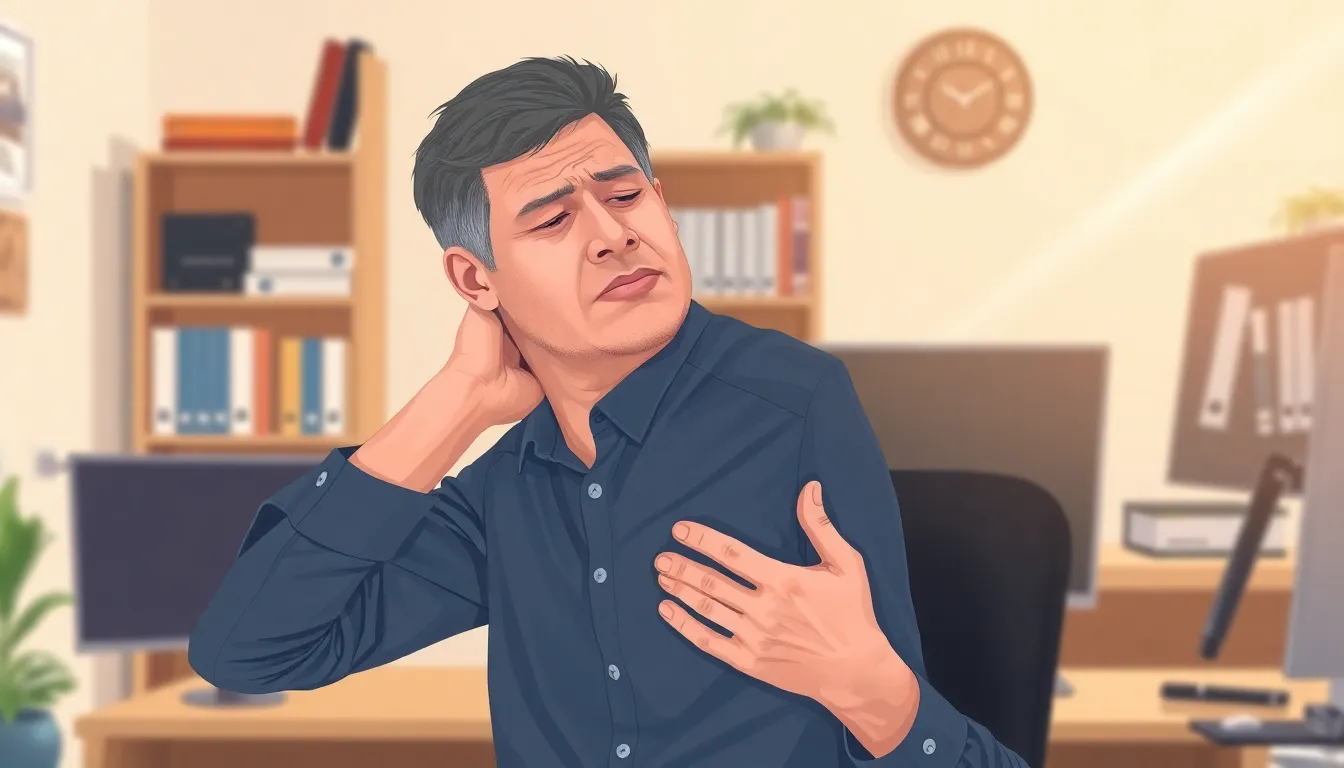Table of Contents
ToggleWhen it comes to nerve root compression, the C6-C7 area is like the grumpy neighbor who just won’t stop complaining. This pesky little issue can lead to a range of symptoms that might make anyone feel like they’re auditioning for a role in a medical drama. From tingling sensations to muscle weakness, the signs can leave you scratching your head—sometimes literally, if you can’t lift your arm!
Overview of C6-C7 Nerve Root Compression
C6-C7 nerve root compression occurs when pressure is applied to the nerve roots in the cervical spine at the C6-C7 level. Symptoms often include pain radiating from the neck down to the arm, specifically affecting the thumb and index finger regions. Tingling or numbness may present in these areas, indicating nerve involvement.
Muscle weakness is another common symptom. Patients may experience difficulty in performing tasks requiring grip strength, affecting daily activities such as holding objects or turning door knobs. This weakness stems from altered communication between the brain and the muscles innervated by the compressed nerve root.
Reflex changes may also occur with C6-C7 nerve root compression. Diminished reflexes in the biceps and wrist may indicate an affected nerve pathway. Observing these reflex changes aids in diagnosis and treatment planning.
Diagnostic methods typically involve imaging, such as MRI or CT scans, which help visualize the compression. Identifying the degree of compression and associated spinal changes is crucial for effective management.
Treatment options can range from conservative approaches, like physical therapy and medication, to surgical intervention if conservative methods prove ineffective. Early recognition and appropriate intervention enhance recovery prospects, reducing chronic symptoms effectively.
Common Symptoms of C6-C7 Nerve Root Compression

C6-C7 nerve root compression presents various symptoms that can significantly affect daily life. Recognizing these symptoms is vital for effective management and treatment.
Pain in Neck and Shoulders
Pain often originates in the neck and radiates to the shoulders. Individuals may feel a persistent ache or sharp discomfort in these areas. Movements like turning the head or lifting objects can worsen the pain. Frequent headaches may accompany this discomfort, further complicating daily activities. Chronic pain can disrupt sleep patterns, leading to fatigue and decreased overall functionality.
Radiating Pain in the Arm
Radiating pain may extend from the neck down through the arm. Patients frequently describe this pain as shooting or electric in nature. It typically affects the area from the shoulder to the thumb. Activities involving reaching or lifting often exacerbate the pain. Radiating pain can hinder work performance and limit participation in recreational activities.
Numbness and Tingling
Numbness and tingling sensations often accompany C6-C7 nerve root compression. These sensations mainly occur in the thumb and index finger, causing significant discomfort. Individuals might also experience a “pins and needles” feeling, which can be distracting. Sensory changes may affect grip strength, making tasks like holding utensils challenging. Prompt identification of these symptoms plays a crucial role in addressing the underlying issues effectively.
Diagnosis of C6-C7 Nerve Root Compression
Diagnosing C6-C7 nerve root compression involves a systematic approach with multiple techniques to ensure accurate identification of the condition.
Imaging Techniques
MRI and CT scans serve as primary imaging techniques for evaluating cervical spine issues. Radiologists use these methods to visualize the spinal canal, nerve roots, and surrounding structures. MRI excels in highlighting soft tissue changes, while CT scans provide excellent bone detail. These images help identify compression points, including herniated discs or bone spurs. Findings from these scans guide physicians in determining the severity of compression and potential treatment options.
Physical Examination
A thorough physical examination plays a vital role in diagnosing C6-C7 nerve root compression. Physicians assess muscle strength, reflexes, and sensory responses during the examination. Weakness in the biceps or triceps may indicate nerve involvement. Sensation tests often focus on the thumb and index finger to identify areas of numbness or tingling. Observations from these tests contribute crucial information for crafting effective treatment plans tailored to the patient’s specific symptoms.
Treatment Options for C6-C7 Nerve Root Compression
C6-C7 nerve root compression treatment varies based on symptom severity and individual patient needs. Both conservative and surgical options exist to alleviate discomfort and restore function.
Conservative Treatments
Conservative treatments often provide effective relief without surgery. Physical therapy focuses on strengthening neck and shoulder muscles, improving flexibility, and reducing pain. Medications like nonsteroidal anti-inflammatory drugs (NSAIDs) can alleviate pain and inflammation. Corticosteroid injections into the epidural space may also offer significant relief for some patients. Activity modifications, such as avoiding heavy lifting and maintaining proper posture, help reduce irritation of the compressed nerve. Using heat or ice packs can also promote comfort and manage symptoms.
Surgical Interventions
Surgical interventions target cases where conservative treatment fails to provide relief. Decompression surgery aims to relieve pressure on the affected nerve roots. Procedures like anterior cervical discectomy involve removing herniated discs, bone spurs, or other structures contributing to compression. Fusion surgery may follow to stabilize the spine. Surgeons evaluate imaging studies and perform physical examinations to determine the necessity for surgery. Successful outcomes from surgery often improve pain levels and restore function in affected areas, enhancing overall quality of life.
C6-C7 nerve root compression can significantly impact daily life through its range of symptoms. Recognizing these signs early is vital for effective management. Patients experiencing persistent neck pain, tingling, or weakness should consult a healthcare professional for a thorough evaluation.
Timely diagnosis through imaging and physical examination can lead to tailored treatment plans that may include conservative measures or surgical options when necessary. By addressing the condition promptly, individuals can improve their quality of life and regain functionality. Prioritizing awareness and intervention is essential for navigating the challenges posed by C6-C7 nerve root compression.




